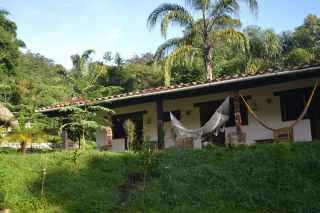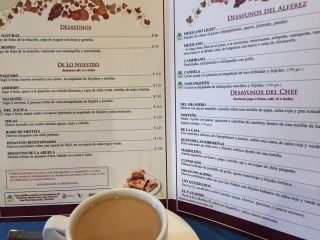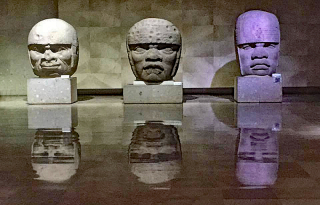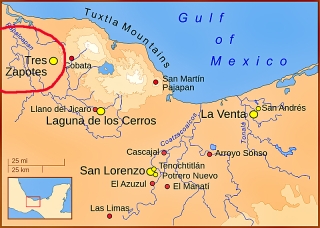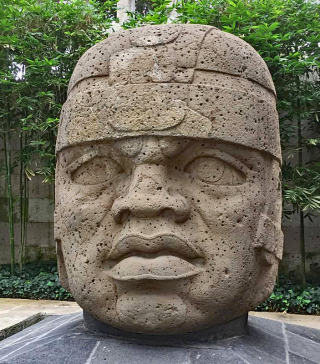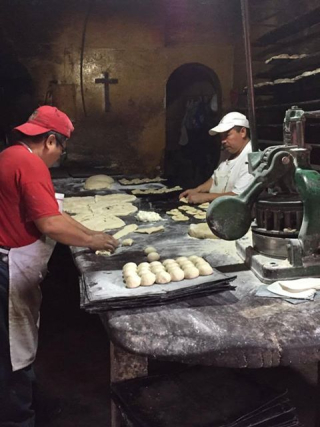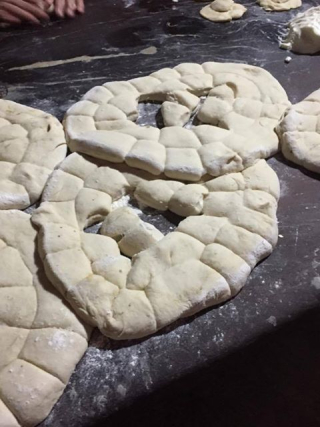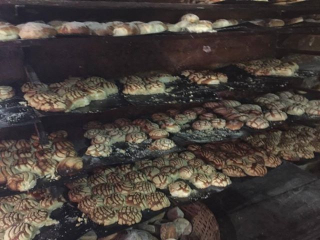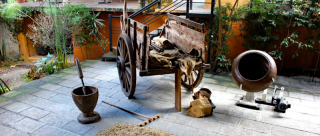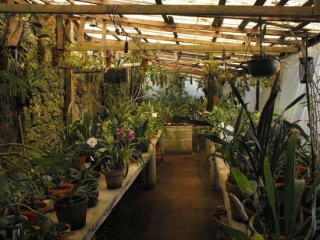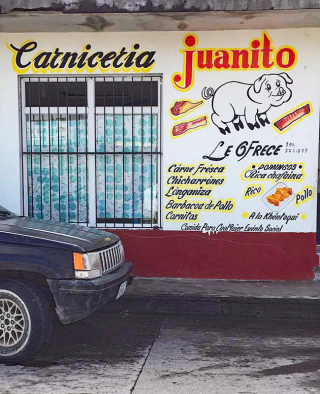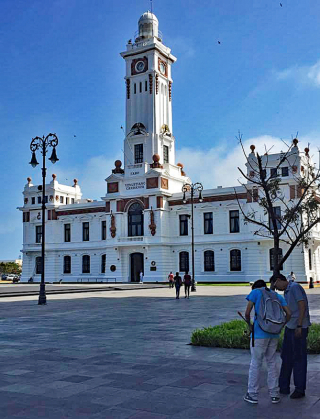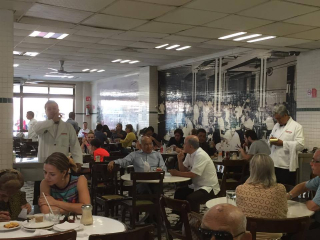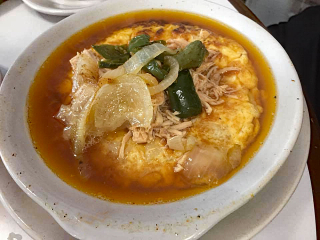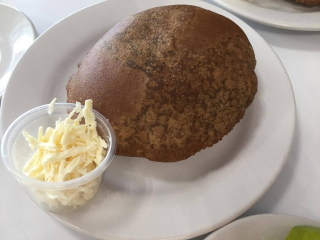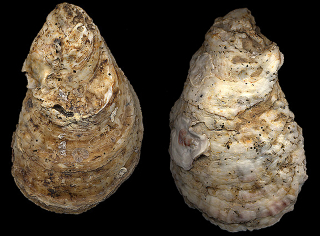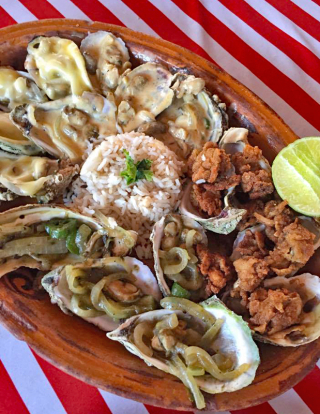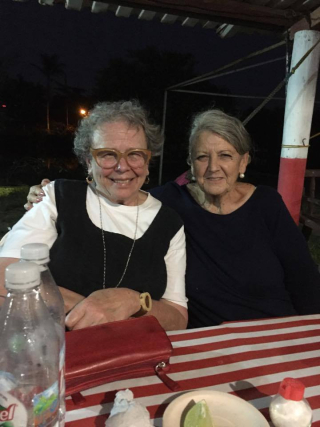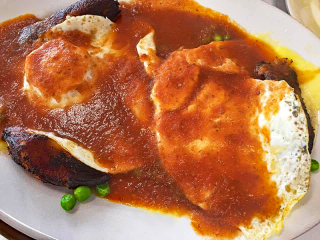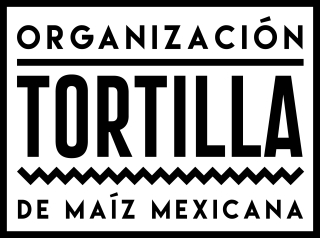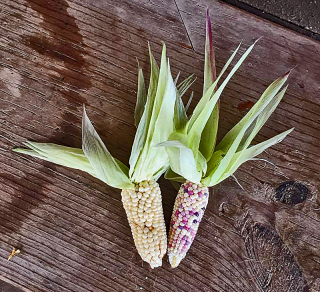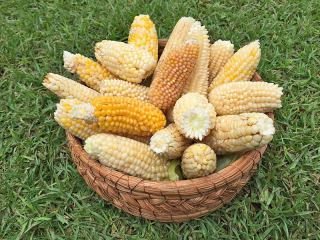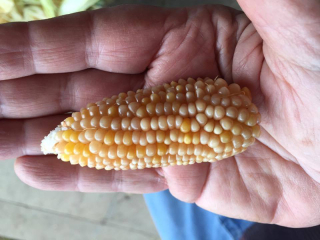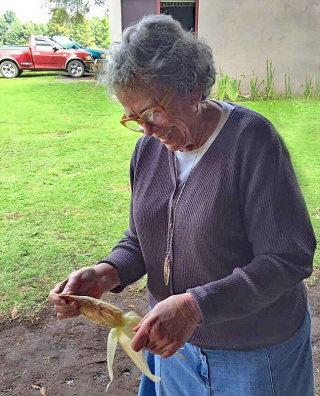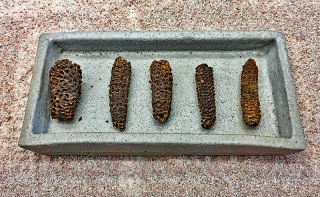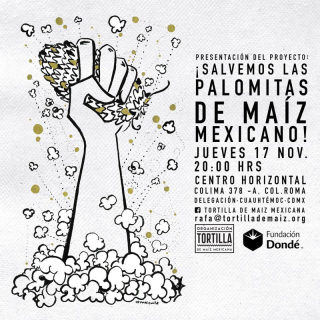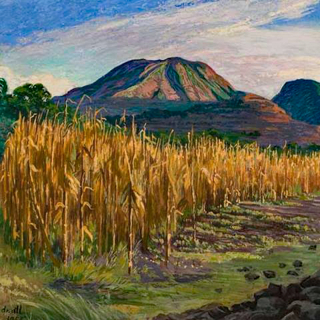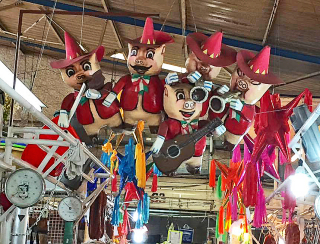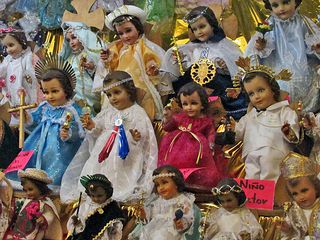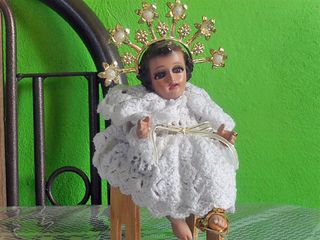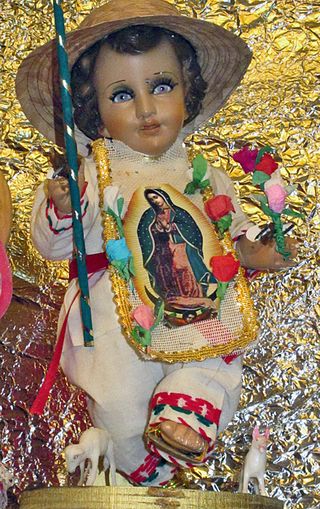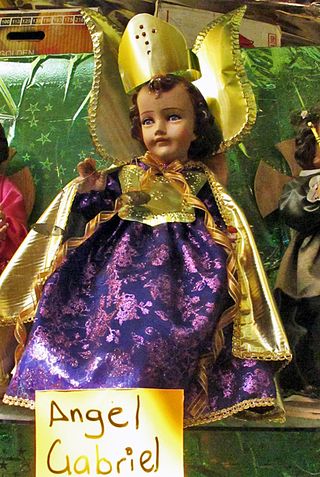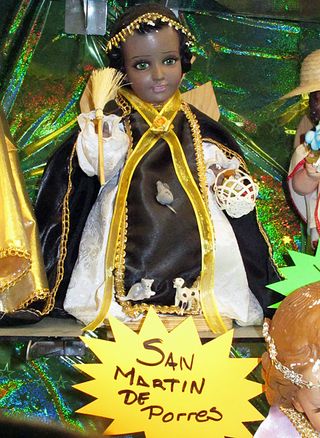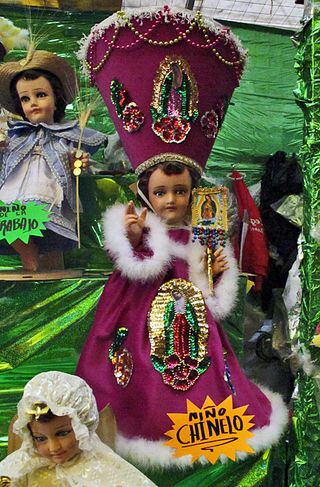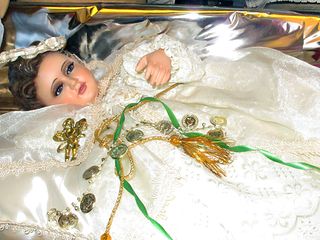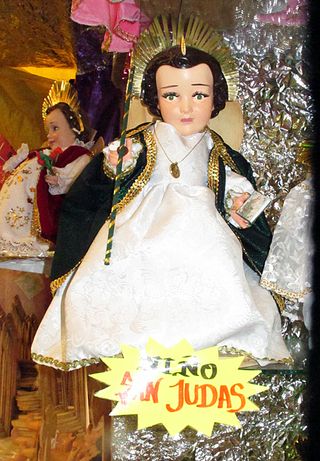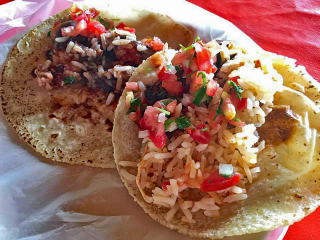
On the way from coastal Casitas to Papantla–a drive of about an hour–you know we got hungry! And what better to have for brunch than roadside tacos, Veracruz style: on the left is milanesa de pollo (lightly breaded and sliced chicken breast with rice, black beans, and salsa) and on the right, pollo deshebrado (boned, simmered, and shredded chicken) with the same condiments. The tacos were truly wonderful, we were delighted with our we-got-lucky-with-roadside-tacos de guisado, home-style tacos filled with stew-y deliciousness.
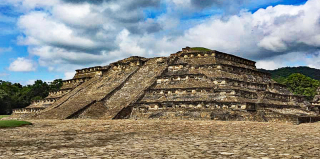
The pyramid El Tajín was our very first stop in Papantla, Veracruz. We went straight to the pyramid site, even before checking into our hotel! El Tajín is not just one pyramid; the archeological site is an entire city. The name, in the Totonaco indigenous language, is believed to mean "place where temples join and smoke is constant", the latter due, to the long ago burning of copal incense in the temples. The photo shows the pirámide de los nichos (Pyramid of the Niches). The name of the pyramid refers to the 365 "windows" placed on all sides of the structure; because the number corresponds to the number of days in a year, this pyramid has received tremendous attention from those who study the calendars and the cosmic vision of the ancient Totonaco inhabitants who, sometime between 1700 and 800 years ago, built this city.
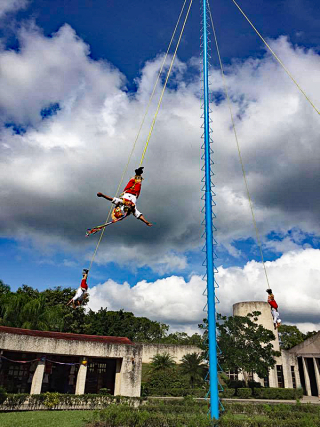
Los Voladores de Papantla (The Papantla Flyers) practice this impressive spiritual ritual on the El Tajín grounds. We made a point to arrive in time for their daily exhibition; the rite had its 450-year-old origins as a form of prayer for rain after a severe drought which left the Totonaco people without food. The Totonacos believe that these prayers to the rain gods brought life-saving rains back to the region. The prayer ceremony initially began with the cutting of a tree tall and straight enough for the flyers; today, the flyers climb the 30 meter high metal pole that you see in the photograph above. Five men participate in this prayer; one remains on a platform at the top of the pole to play ritual music meant to mimic birdsong; the other four launch themselves from the platform to fly upside down to the ground. There is ceremony and prayer form in every part of the rite. The pole is the connection point between earth, the underworld, and the sky; the flyers represent the four cardinal points and the four elements (earth, air, water, and fire); each rope is wrapped 13 times around its flyer, and the flyers circle the pole 52 times, representing the length in weeks of the Mesoamerican great year. All photos and videos copyright Mexico Cooks! unless otherwise noted.
[youtube=https://www.youtube.com/watch?v=ZpX9H1fYB0E&w=560&h=315]
Los Voladores de Papantla in motion–with the musician playing his drum and flute on the platform! Together, the five flyers form a living, moving pyramid. Video copyright Mexico Cooks!.
[youtube=https://www.youtube.com/watch?v=WOqRSc9gIuY&w=560&h=315]
In the Totonac region, the flyers are required to know and speak Totonaco. Most boys and young men learn the rituals and the dances from their fathers and grandfathers. Mastering the ceremonies can take as long as 10 to 12 years and the flyers and dancers usually commit themselves for life. In this video, a boy no more than three years old carefully followed the steps and gestures of the dancers on the platform. I asked; the boy is the son of one of the dancers, learning from his father and the rest of the group. Video copyright Mexico Cooks!.
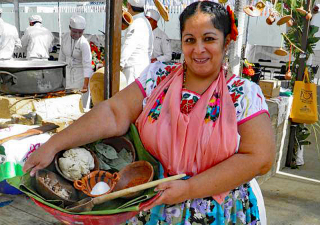
When we finished at El Tajín, we paid a visit to the well-known Totonaca cocinera tradicional (traditional cook) Martha Soledad Gómez Atzin at her cocina de humo (traditional kitchen where cooking is done over firewood), close to the pyramid site. Her group, Las Mujeres de Humo, continues to give demonstrations and classes in Totonaco regional cooking.

The group of women (Las Mujeres de Humo) who work with Martha Gómez Atzin to preserve and protect the Totonaca kitchen.
Beginning in 2000, the cocina de humo has formed a part of the international festival Cumbre Tajín, which promotes music, art, and traditional cuisine in northern Veracruz. The Cumbre (summit) was founded under the impetus of the then-governor of Veracruz. The realization of the event met with strong opposition from INAH (National Institute of Anthropology and History), from the custodians of the archeological site, from students at ENAH (the National School of Anthropology and History), and from the central organization of people and farm workers, all of whom believed that the festival was an illegal commercialization of archeological heritage. Differences exist between those who believe that the festival is an exploitation rather than a preservation of tradition and who say that the festival itself damages the archeological site and the promoters, as opposed to those who applaud the festival as a tourist attraction and money-making proposition. The festival, despite its controversial nature, has persevered.
In 2001, Parque Takilhsukut, a theme park approximately one kilometer outside El Tajín archeological site, opened in answer to opposition to the Cumbre. Most Cumbre events were moved to that park; only a nightly sound and light show continues at the pyramid site. Although the government intended the theme park to be a center of indigenous life and tradition, the only activity the day we were there was at the cocina de humo. Sra. Atzin and her group of cocineras tradicionales were cooking comida (the main meal of the day in Mexico) for themselves, but no group of students or guests was in the kitchen. Sra. Atzin talked extensively to me about the Veracruz government's failure to continue funding and support for their efforts. Until fairly recently, the cocina de humo offered many buzzing classes to school children and older people alike, including transportation from their towns to the theme park. Today, the bankrupt Veracruz government has no funds to offer.
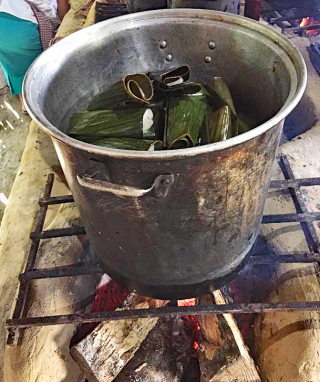
In the pot are tamales pintos, a Totonaco specialty that wraps a mixture of fresh, light masa (corn dough) with newly harvested, tender black and white beans known as pintos ('painted') in hoja de plátano (banana leaves). Las mujeres de humo treated us to the first two delicious pintos to come out of the pot.
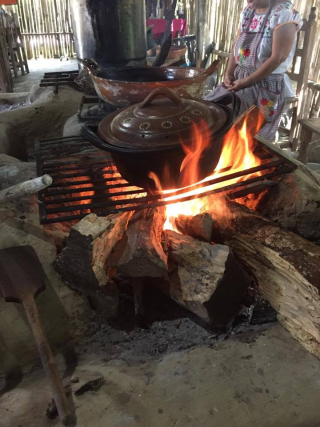
Preparing the rest of the midday meal.
Next week, come with Mexico Cooks! on the last leg of this journey in Veracruz: vanilla production in Papantla! We learned more about the origin, harvest, and importance of vanilla than we thought possible, and so will you. Plus, we ate regional Totonaca food that we're still dreaming about, and prolonged our trip till we really couldn't stay longer. Such fun!
Looking for a tailored-to-your-interests specialized tour in Mexico? Click here to see new information: Tours
